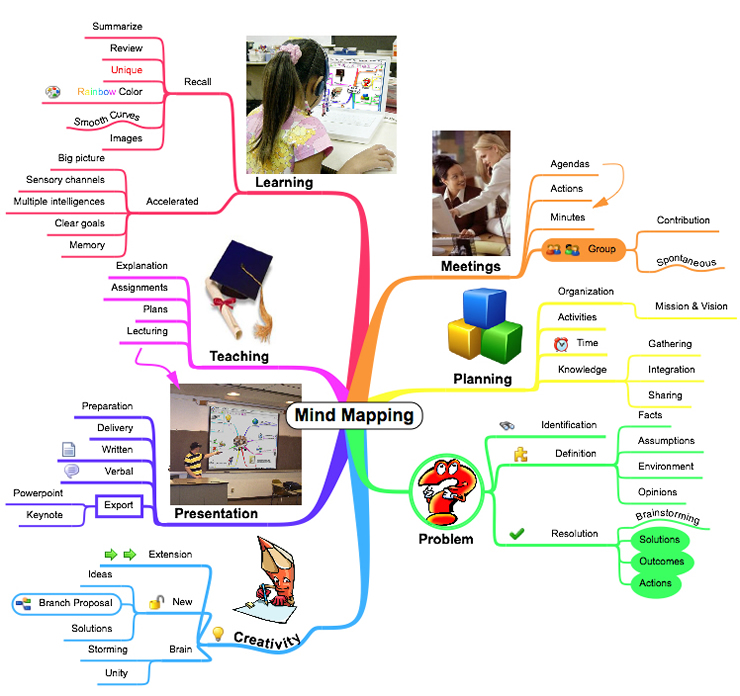ผังมโนภาพ
ผังมโนภาพ หรือ แผนที่ความคิด หรือ ไมด์แม็ป
ผังมโนภาพ หรือ แผนที่ความคิด หรือ ไมด์แม็ป (อังกฤษ: mind map) คือไดอะแกรม ที่แสดงให้เห็นถึงความเชื่องโยงของมโนภาพที่สัมพันธ์กันรูปแบบหนึ่ง โดยปกติจะใช้รูป วงกลมแทนมโนภาพ หรือความคิด และเส้นลูกศรแทนลักษณะ และทิศทางของความสัมพันธ์นั้น มีคำกำกับไว้ว่า วงกลมแทนมโนภาพของอะไร เส้นลูกศรแทนความสัมพันธ์ใน ลักษณะ และทิศทางใด ในบางครั้งมีการใช้การเน้นและแจกแจงเนื้อความด้วยสี และการวาดรูปประกอบ ในสถานศึกษาหลายแห่ง ได้มีการกล่าวถึง การใช้ผังมโนภาพเกินความจำเป็น เนื่องจากคำโฆษณาเกินจริง เกี่ยวกับการใช้สมองทั้งซีกซ้ายและสมองซีกขวา ที่มีการพิสูจน์ในลักษณะของรูปแบบวิทยาศาสตร์ลวง
โทนี บูซาน (Tony Buzan) เป็นชาวอังกฤษ เป็นผู้ได้ริเริ่ม พยายามนำเอาความรู้เรื่อง สมองมาปรับใช้กับการเรียนรู้ของเขา โดยพัฒนาการจากการจดบันทึกแบบเดิม ที่จดบันทึกเป็นตัวอักษรเป็นบรรทัด ๆ เป็นแถว ๆ ใช้ปากกาหรือดินสอสีเดียวมาเป็นการบันทึก ด้วยคำ ภาพ สัญลักษณ์ แบบแผ่เป็นรัศมีออกรอบ ๆ ศูนย์กลางเหมือนกับ การแตกแขนงของกิ่งไม้ โดยใช้สีสัน ต่อมาเขาก็พบว่า วิธีที่เขาใช้นั้นสามารถนำไปใช้กับกิจกรรมอื่นในชีวิตส่วนตัวและชีวิตการงานได้ด้วย เช่น ใช้ในการวางแผน การตัดสินใจ การช่วยจำ การแก้ปัญหา การนำเสนอ การเขียนหนังสือ เป็นต้น ซึ่งโทนี บูซาน ได้เขียนหนังสือ Use you Head (ใช้หัวคิด) และ Get Ahead (ใช้หัวลุย) ร่วมกับแวนด้า นอร์ธ (Vanda North) และนายธัญญา ผลอนันต์ ผู้แปลเป็นฉบับภาษาไทย ซึ่งเป็นผู้ที่นำแนวคิด วิธีการน้ำเข้ามาเผยแพร่ในประเทศไทย ผู้เขียนได้มีโอกาสศึกษาเรื่องนี้กับคุณธัญญา ผลอนันต์ และพบว่าวิธีการของ MIND MAP นั้นสามารถนำไปใช้ได้ ทั้งชีวิตส่วนตัว และการงานจริง และเห็นว่าถ้านำแนวคิด เทคนิค วิธีการนี้ขยายผลในการศึกษา น่าจะเป็นประโยชน์อย่างยิ่งกับผู้ที่มีหน้าที่จัดการเรียนรู้ เริ่มตั้งแต่การวางแผนจัดการเรียนรู้ การจัดกิจกรรมต่าง ๆ ในการเรียนรู้ สำหรับผู้เรียนนั้นจะสามารถพัฒนาทักษะในการเรียนรู้ ศาสตร์และศิลปะด้านต่าง ๆ ได้อย่างมีประสิทธิภาพมากขึ้น เช่น สามารถช่วยคิด จำ บันทึก เข้าใจเนื้อหา การนำเสนอข้อมูลและช่วยแก้ปัญหาได้อย่างเป็นรูปธรรม ทำให้การเรียนรู้เป็นเรื่องที่สนุกสนาน มีชีวิตชีวายิ่งขึ้น

หลักการเขียน Mind Map
การเขียน Mind Map ใช้กระดาษแผ่นเดียว การเขียนใช้สีสันหลากหลาย ใช้โครงสร้างตามธรรมชาติที่แผ่กระจายออกมาจุดศูนย์กลาง ใช้เส้นโยง มีเครื่องหมาย สัญลักษณ์ และรูปภาพที่ผสมผสานร่วมกันอย่างเรียบง่าย สอดคล้องกับการทำงานตามธรรมชาติของสมอง
วิธีการเขียน Mind Map
1. เตรียมกระดาษเปล่าที่ไม่มีเส้นบรรทัดและวางกระดาษภาพแนวนอน
2. วาดภาพสีหรือเขียนคำหรือข้อความที่สื่อหรือแสดงถึงเรื่องจะทำ Mind Map กลางหน้ากระดาษ โดยใช้สีอย่างน้อย 3 สี และต้องไม่ตีกรอบด้วย รูปทรงเรขาคณิต
3. คิดถึงหัวเรื่องสำคัญที่เป็นส่วนประกอบของเรื่องที่ทำ Mind Map โดยให้เขียนเป็นคำ ที่มีลักษณะเป็นหน่วย หรือเป็นคำสำคัญ (Key Word) สั้น ๆ ที่มีความหมาย บนเส้น ซึ่งเส้นแต่ละเส้นจะต้องแตกออกมาจากศูนย์กลางไม่ควรเกิน 8 กิ่ง
4. แตกความคิดของหัวเรื่องสำคัญแต่ละเรื่องในข้อ 3 ออกเป็นกิ่ง ๆ หลายกิ่ง โดยเขียนคำหรือวลีบนเส้นที่แตกออกไป ลักษณะของกิ่งควรเอนไม่เกิน 60 องศา
5. แตกความคิดรองลงไปที่เป็นส่วนประกอบของแต่ละกิ่ง ในข้อ 4 โดยเขียนคำหรือวลีเส้นที่แตกออกไป ซึ่งสามารถแตกความคิดออกไปเรื่อยๆ
6. การเขียนคำ ควรเขียนด้วยคำที่เป็นคำสำคัญ (Key Word) หรือคำหลัก หรือเป็นวลีที่มีความหมายชัดเจน
7. คำ วลี สัญลักษณ์ หรือรูปภาพใดที่ต้องการเน้น อาจใช้วิธีการทำให้เด่น เช่น การล้อมกรอบ หรือใส่กล่อง เป็นต้น
8. ตกแต่ง Mind Map ที่เขียนด้วยความสนุกสนานทั้งภาพและแนวคิดที่เชื่อมโยงต่อกัน
ข้อดีของการทำแผนที่ความคิด
1. ทำให้เห็นภาพรวมกว้าง ๆ ของหัวข้อใหญ่ หรือขอบเขตของเรื่อง
2. ทำให้สามารถวางแผนเส้นทางหรือตัดสินใจได้อย่างถูกต้อง เพราะรู้ว่าตรงไหนกำลังจะไปไหนหรือผ่านอะไรบ้าง
3. สามารถรวบรวมข้อมูลจำนวนมากลงไว้ในกระดาษแผ่นเดียวกัน
4. กระตุ้นให้คิดแก้ไขปัญหา โดยเปิดโอกาสให้มองเห็นวิธีใหม่ ๆ ที่สร้างสรรค์
5. สร้างความเพลิดเพลินในการอ่านและง่ายต่อการจดจำ
สรุป Mind Map เป็นแผนที่ความคิดที่อัจฉริยะ เปรียบเสมือนลายแทงที่นำไปสู่ การจดจำ การเรียบเรียง การจัดระเบียบข้อมูลตามธรรมชาติ การทำงานของสมองตั้งแต่ต้น นั่นหมายความว่า การจำและฟื้นความจำ หรือการเรียกข้อมูลเหล่านั้นกลับมาใช้ในภายหลัง จะทำได้ง่าย และมีความถูกต้องแม่นยำกว่าการใช้เทคนิคการจดบันทึกแบบเดิม
Naturally, the new trend is making these tools available to iPhone, iPad and Android mobile platforms.
(1) Bubble.us
Bubble.us is a great place to start. Simple and easy, there is plenty of free training available, too. You can start creating right off the bat. You don’t even need to create an account.
(2) Mindomo.com
Mindomo comes in a free and paid version. The free version limits the number of private mind maps to three and sharing is disabled. The output looks terrific, though. The mobile app is free. If you’re okay with paying for the mobile access, this may be just right for you to do your mind mapping on the run.
(3) Mind42.com
Why do I love Mind42? It’s first class, it’s free, it’s fun and it’s fully featured. Publish, collaborate, brainstorm, import, export and revise. Mind42 does it all at no cost to you.
(4) Labyrinth
Labyrinth is a simple basic easy to use mind mapping software for Linux and Windows. Widely available, it’s small in size, automatically saves your work, makes it easy to add images and offers a simple way to add notes (not all mind mapping software offers this). It’s a great free way to give your brilliant thoughts a bright colorful new visual dimension. The best thing to do is just give it a try.
(5) WiseMapping.com
WiseMapping is another cool tool in the mind mapping arena. It is one of the newer players. It is open source and unlimited. Since it is a web app, you are not chained to any particular computer. Like I said, there is an embarrassment of riches here.
(6) TheBrain.com
This is another offering with a free and paid version. Some sources say it is the most intuitive of all the mind mapping software today. Plus it enthusiastically asserts that you can organize and manage your entire business and personal life with — you guessed it — one of their mind maps. Intriguing stuff, to be sure. Available for Windows, Mac and Linux. This software was previously called PersonalBrain.
(7) Blumind.org
Blumind for Windows is another fully featured mind mapping software with all the basic stuff you need. It has been around for awhile and has many fans. Track your thoughts. See new connections between them. I like the clean colorful look of the Blumind mind maps.
(8) Freemind.Sourceforge.net
FreeMind describes itself as the “premier free mind-mapping software written in Java.” Even if you’ve never mind mapped before, you have almost certainly seen somebody presenting live or on a webinar with a FreeMind mind map. More than 4,000 people download FreeMind every day. It’s hard to argue with that kind of popularity. Plus people who use mind maps are smart to begin with.
They’ve been around for ages in Internet years and are still going strong. FreeMind was a finalist for a 2009 Community Choice Award in the category “Most likely to change the way you do everything.”
(9) XMind.net
Open source and ready for Windows, Mac and Linux, XMind may be the best looking of the crew. While there is a paid version, the free version should be robust enough for all your needs. XMind and FreeMind are the top dogs of the free mind mapping software kingdom. So be sure to check them out!
(10) MindMeister has free and paid options but like most of the others, the free version is adequate for all but high voltage power users. It verges on being too simple, but that is its advantage. The controls are minimal. Take it for a test drive.
Okay, that’s the top 10 free mind mapping software. In another post I recommended Edraw MindMap from Edrawsoft, so check that out, too. It’s completely free and the quality is excellent.